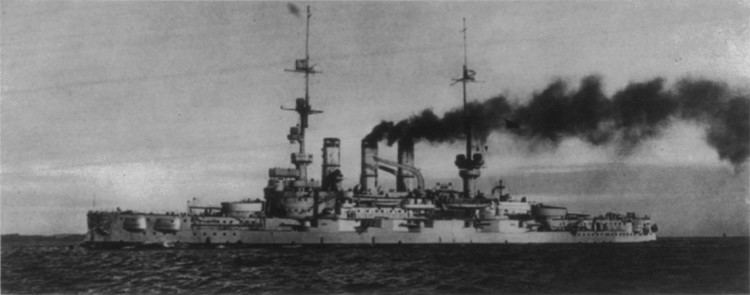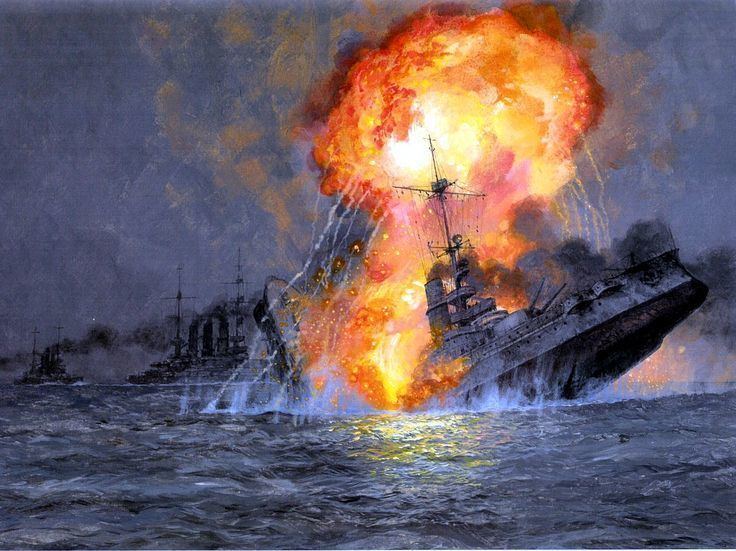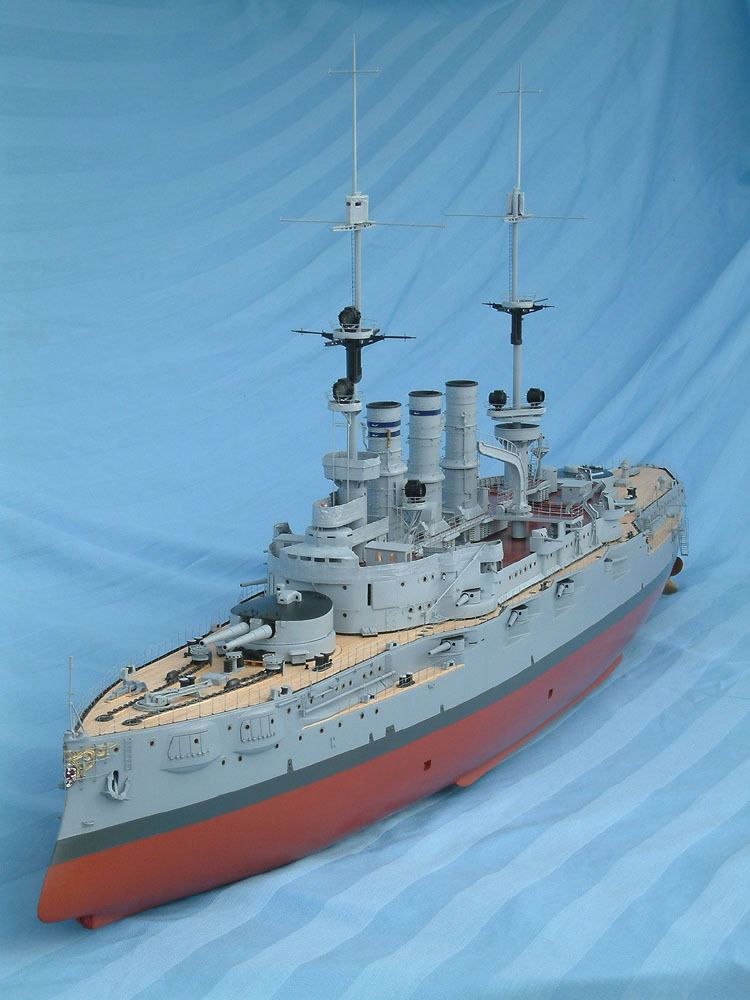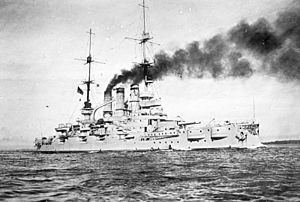Name Pommern Laid down 22 March 1904 Construction started 22 March 1904 Length 128 m | Commissioned 6 August 1907 Launched 2 December 1905 | |
 | ||
Sms pommern
SMS Pommern was one of five Deutschland-class pre-dreadnought battleships built for the Kaiserliche Marine between 1904 and 1906. Named after the Prussian province of Pomerania, she was built at the AG Vulcan yard at Stettin, where she was laid down on 22 March 1904 and launched on 2 December 1905. She was commissioned into the navy on 6 August 1907. The ships of her class were already outdated by the time they entered the service, being inferior in size, armor, firepower, and speed to the revolutionary new battleship HMS Dreadnought.
Contents

After commissioning, Pommern was assigned to the II Battle Squadron of the High Seas Fleet, where she served throughout her peacetime career and the first two years of World War I. During this period, Pommern participated in several fruitless sorties into the North Sea in attempts to lure out and destroy a portion of the British Grand Fleet. The ship was present at the Battle of Jutland on 31 May – 1 June 1916. She and her sisters briefly engaged the British battlecruisers commanded by David Beatty; Pommern was hit once by a 12 in (30.5 cm) shell from the battlecruiser HMS Indomitable. During the confused night actions in the early hours of 1 June, she was hit by one, or possibly two, torpedoes from the British destroyer HMS Onslaught, which detonated one of Pommern's 17-centimeter (6.7 in) gun magazines. The resulting explosion broke the ship in half and killed the entire crew. Pommern was the only battleship of either side sunk during the battle.

Construction

Pommern was ordered under the contract name "O". She was laid down on 22 March 1904 at the AG Vulcan dockyard in Stettin. She was originally scheduled to be launched on 19 November 1905, but the water level in the harbor was too low. As a result, the ship could not be launched until 2 December. The Oberpräsident of Pommern, Helmuth von Maltzahn, gave the launching speech. In July 1907 Pommern was transferred to Kiel where she had her main battery of four 28 cm (11 in) guns installed. She was commissioned for trials on 6 August; during her speed run, she made 18.7 knots (34.6 km/h; 21.5 mph), which made her the fastest pre-dreadnought battleship in the world.

The ship was 127.6 m (418 ft 8 in) long and had a beam of 22.2 m (72 ft 10 in), and a draft of 8.21 m (26 ft 11 in). Her full-load displacement was 14,218 metric tons (13,993 long tons). She was equipped with triple expansion engines that were rated at 17,453 indicated horsepower (13,015 kW) and a top speed of 18 knots (33 km/h; 21 mph). Steam was provided by twelve Schulz-Thornycroft boilers. In addition to being the fastest ship of her class, Pommern was the most fuel efficient. At a cruising speed of 10 knots (19 km/h; 12 mph), she could steam for 5,830 nautical miles (10,800 km; 6,710 mi). The ship had a peacetime crew of 35 officers and 708 enlisted men, though during military operations, the size of the crew expanded.
Pommern's primary armament consisted of four 28 cm (11 in) SK L/40 guns in two twin turrets. She was equipped with fourteen 17 cm (6.7 in) guns mounted in casemates and twenty 8.8 cm (3.5 in) guns in pivot mounts. The ship was also armed with six 45 cm (17.7 in) torpedo tubes, all submerged in the hull. One was in the bow, one in the stern, and four on the broadside. Her armored belt was 240 mm (9.4 in) thick amidships and she had a 40 mm (1.6 in) thick armored deck. The main battery turrets had 280 mm (11 in) thick sides.
Service history
Pommern was assigned to the II Battle Squadron of the High Seas Fleet alongside her sisters. She took part in the annual training cruises and maneuvers with the rest of the High Seas Fleet between 1908 and 1914. This included fleet training in the Baltic in 1908 and a cruise into the Atlantic the following year. In May 1910 Pommern took part in fleet training in the Kattegat between Denmark and Norway, followed by a cruise to Norway in the summer. At the end of 1910, the fleet conducted another cruise into the Baltic. The next two years followed a similar pattern, though the summer cruise in 1912 was interrupted by the Agadir Crisis. As a result, the cruise was only into the Baltic. Later in the year Pommern took part in maneuvers off the island of Helgoland in the North Sea.
In July 1914, about two weeks after the assassination of Archduke Franz Ferdinand in Sarajevo, Pommern was with the High Seas Fleet during its annual summer cruise to Norway. As a result of rising international tensions, the cruise was cut short and the German fleet was back in Wilhelmshaven by 29 July. At midnight on 4 August, the United Kingdom declared war on Germany. Pommern remained with the High Seas Fleet throughout the first two years of the naval war. At the outbreak of war, the ship and her sisters in the II Battle Squadron were deployed to the mouth of the Elbe River to guard the area from possible British incursions.
Pommern and the rest of the II Battle Squadron then rejoined the High Seas Fleet as part of the battleship support for the battlecruisers in the I Scouting Group that bombarded Scarborough, Hartlepool, and Whitby on 15–16 December 1914. During the operation, the German battle fleet of some twelve dreadnoughts and eight pre-dreadnoughts came to within 10 nmi (19 km; 12 mi) of an isolated squadron of six British battleships. However, skirmishes between the rival destroyer screens convinced Admiral Friedrich von Ingenohl that he was confronted with the entire Grand Fleet, and so he broke off the engagement and turned for home. Two fruitless fleet advances followed on 17–18 and 21–23 April 1915. A third took place on 17–18 May, and a fourth occurred on 23–24 October.
On 24–25 April 1916, Pommern and her sisters joined the dreadnoughts of the High Seas Fleet to support the battlecruisers, which were again tasked with conducting a raid of the English coast. While en route to the target, the battlecruiser Seydlitz was damaged by a mine. Seydlitz was detached to return home, and the rest of the ships continued with the mission. Due to poor visibility, the battlecruisers conducted a brief bombardment of the ports of Yarmouth and Lowestoft. The operation was quickly called off, which prevented the British fleet from being able to intervene.
Battle of Jutland
Vice Admiral Reinhard Scheer, the new commander of the High Seas Fleet, immediately planned another foray into the North Sea, but the damage to Seydlitz delayed the operation until the end of May. Pommern remained assigned to the II Battle Squadron, now under the command of Rear Admiral Franz Mauve. The squadron was positioned at the rear of the German line. During the "Run to the North," Scheer ordered the fleet to pursue the British V Battle Squadron at top speed. The slower Deutschland-class ships could not keep up with the faster dreadnoughts and quickly fell behind.
Later in the evening of the first day of the battle, the hard-pressed battlecruisers of the I Scouting Group were being pursued by their British opponents. Pommern and the other so-called "five-minute ships" came to their aid by steaming in between the opposing battlecruiser squadrons. Pommern could not make out a target in the darkness, though several of her sisters could. Despite this, their shooting was ineffective. The British battlecruisers scored several hits on the German ships, including one on Pommern by a 12 in (30.5 cm) shell fired by Indomitable, forcing her to haul out of line. Admiral Mauve ordered an 8-point turn to the south to disengage from the British, and they did not follow.
At 3:10 on the morning of 1 June, Pommern was torpedoed by the British destroyer Onslaught. At least one torpedo, and possibly a second, struck the ship, detonating one of the 17 cm ammunition magazines. A tremendous explosion broke the ship in half. The stern capsized and remained afloat for at least 20 minutes with her propellers jutting into the air. Hannover, the ship directly astern of Pommern, was forced to haul out of line to avoid the wreck. Pommern's entire crew of 839 officers and enlisted men were killed when the ship sank. She was the only battleship, pre-dreadnought or dreadnought, in either fleet to be sunk at Jutland; her loss, coupled with the vulnerabilities of the surviving pre-dreadnoughts, prompted Scheer to leave them behind during the sortie of 18–19 August 1916.
